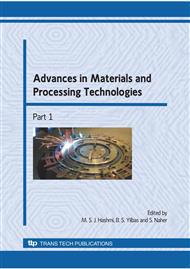p.421
p.429
p.439
p.449
p.457
p.465
p.473
p.481
p.489
Crude Oil and Outdoor Temperature Effects on the Tensile and Creep Properties of Glass Fiber Reinforced Vinylester Composite Pipes
Abstract:
Composites are overtaking their traditional counterpart materials by prooving themselves to be superior alternatives even for their application in harsh environmental conditions. The technological innovations and developments in manufacturing processes, which lead to a wide range of new composite products, have made them attractive candidates for applications in oil & gas industry, with their application ranging from oil production to transportation. Lack of enough data regarding their long-term environmental and mechanical durability has been a major hinderance in their full-fledge application. This paper investigates the effect on the tensile and creep strength of filament wounded E-glass/vinylester composite pipes (GFRV) exposed to a combination of crude oil and outdoor temperature conditions of Dhahran. The variation in the tensile and creep properties is considered for exposure periods of 6, 12 and 24 months. The combined crude oil filled GFRV pipes exposed to outdoor environmental conditions for a periods of 6, 12 and 24 months have shown a constant increase in the tensile and creep strengths respectively, when compared with the as-received GFRV samples. This increase in the tensile and creep strengths may be attributed to the dual curing of the GFRV pipes i.e both the outer side and inner side of the pipes due to outdoor temperature and crude oil respectively. Microscopic analysis of fractured surfaces using optical microscope and SEM is used to characterize the failure mechanisms responsible.
Info:
Periodical:
Pages:
457-464
Citation:
Online since:
December 2009
Authors:
Keywords:
Price:
Сopyright:
© 2010 Trans Tech Publications Ltd. All Rights Reserved
Share:
Citation:


